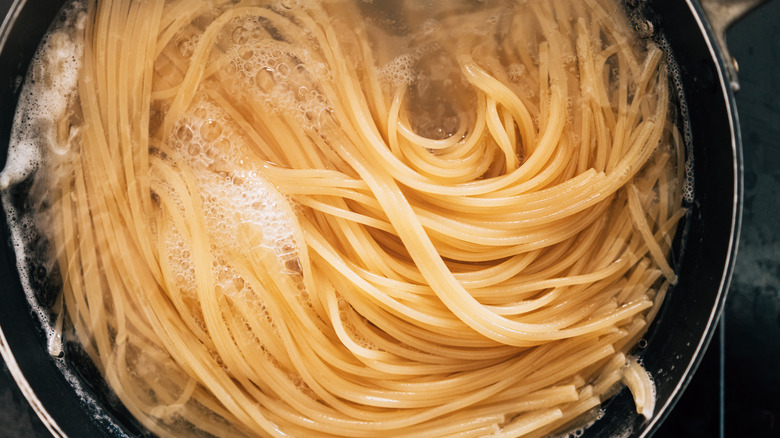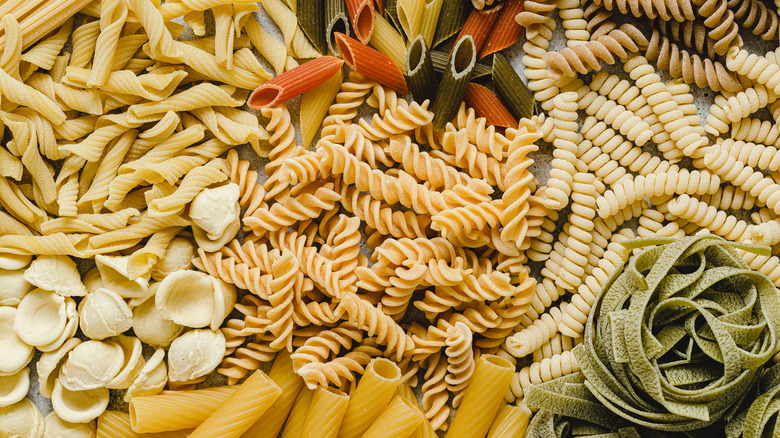The World's Oldest Pasta Shape Would Be Unrecognizable Today
There are more shapes of pasta than anyone can say... literally. Nobody is certain exactly how many varieties of pasta are out there. Many publications have put the number of pasta shapes around 350, but this is only a rough estimate. It's tricky to clearly define any given pasta shape because in Italy, the same shape may go by different names from one region to the next. The reverse is also true, with people applying the same name to various pasta shapes. The full catalog of pasta shapes is vast, but none of the ones we eat today is close to the original.
The invention of Italian pasta didn't actually happen in Italy. Noodles originated in China and were later introduced to the Middle East, where people started making them with durum wheat. Since durum is the defining ingredient of pasta, this indicates that the first form of pasta came from the Middle East. The earliest pasta shape would have been a sheet but not quite like the ones we use to make lasagna nowadays.
The first pasta was more akin to boiled matzo bread. What really set it apart from today's pasta was the cooking, as up until the Renaissance era, pasta was to be boiled for much longer periods, leaving it soft rather than the 'al dente' texture sought after today. This wasn't the only pasta shape to come out of the Middle East, though. In fact, many of our modern favorites have Arab origins.
The Arab influence on pasta
Written references to pasta appeared in the Middle East long before Italy, with the earliest known reference to boiled noodles outside of Asia coming from the fifth-century Jerusalem Talmud. It's also thought that Arabs were the first to dry noodles, which they did to preserve the food for travel. Some of the basic long pasta shapes, like spaghetti and vermicelli, are thought to have been invented in the Arab world and later introduced to Italy, where they got their familiar names.
The Italian island of Sicily was under Muslim rule from the ninth to 11th centuries, following an invasion by the Aghlabid emirate of North Africa. This is roughly when the durum wheat noodles originally invented by Arabs were first introduced to the region we now know as Italy. Durum wheat's hardy nature and long shelf life made pasta (as well as related products like couscous) into staples for the peasant class and ultimately, Italy as a whole.
How pasta shapes get their names
For centuries, most pasta shapes were just variations of the same basic formula — thin noodles cut by hand from a big sheet of pasta dough. But in the 14th century, people finally began experimenting with extruded pasta, paving the way for the bronze cut pasta of today, and all its many shapes. By the time of the Renaissance, pasta was being mass-produced, and all the new and inventive shapes people were coming up with needed to be named.
The first pasta shapes didn't have unique names, it seems, as early Arabic sources refer to all noodles as "itriyah." However, by the 10th century, Arabic texts had more firmly defined itriyah as dried noodles, while fresh ones were known as "lakhsha."
In Italy, pasta shapes are often named for other objects with a similar shape. For example, spaghetti comes from the Italian word "spago," which means "string," and orecchiette comes from the Italian "orecchio," meaning "ear." Gnocchi has two possible sources—it may come from the word "nocchio," referring to a knot in wood, or it may come from "nocca," meaning knuckle (although many argue that gnocchi isn't actually pasta). Italian pasta names also include suffixes that typically relate to their size, such as "-ini" and "etti," denoting something small, or "oni" and "one" referring to something large.


